Measuring the angle
This task is about measuring and drawing angles.
Some friends are building some skateboard ramps.They have to make sure they know how to measure angles.
| a) |
Use a protractor to measure and record the angle of each slope.
|
||
| i) | ii) | iii) | |
 |
 |
 |
|
| Angle w = _______° | Angle x = _______° | Angle y = _______° | |
|
|
|||
| b) |
On the lines below draw and label the following angles using a protractor.
|
|||
| i) | 40° angle | ii) | 160° angle | |
|
|
|
|||



